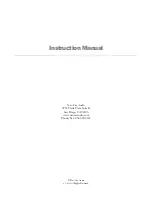
DS1043-261
13
LBT20960
SWITCHING ON THE CONTROL PANEL AND INITIALISING THE LINES
With the system fully wired, including batteries, power the control panel through the mains disconnector. The display will switch on
and the "
power
" indicator light will appear on the front panel of the control panel.
Wait for the fault message prompting you to update the time and date of the internal clock of the control panel to appear. To update
the clock, enter the service menu by pressing the
“
MENU
" key. Enter the default password "
22222
" followed by the "
OK
" key pressing
the keys on the display.
After updating the clock, press the "
RESET
" button and wait for the message "
MONITORING NOT POSSIBLE
" to appear on the
display
Then switch to the programming phase using the
“
MENU
”
key.
Select "
[1] PROGRAMMING
", confirm by pressing "
OK
", enter the password "
33333
" and press the "
OK
" key.
In the main programming menu, press the "
ACK
" key to acquire the programming step and switch off the buzzer.
Proceed with line initialisation by selecting the following items
“
[1] CIRCUIT
”- “
[2] CONFIGURE SINGLE CIRCUIT
”.
Enter the number of one of the lines to be initialised and confirm with
“
OK
”.
Select the loop or open line configuration type and then the initialisation mode "
[1] AUTO-ADDRESSED MODE
". Press “
OK
” to
confirm.
The control panel will initialise the selected line and at the end it will display the list of detected devices. Press the "
OK
" key is
confirmed
“
OK
”.
Press the "
ESC
" key several times to go back to the line number entry screen and allow other detection lines to be initialised.
In the event of errors or line faults signalled by the control panel, refer to the installation and/or programming manual for details of the
error or fault.
Functional check
– monitoring phase
At the end of the initialisation phase of all the lines, a functional check can be carried out on the entire system to valida te all the
connections.
To do this, it is necessary to start the scanning phase, i.e. the functional phase of the fire alarm system during which all the de vices
are controlled and monitored to perform the required measurements (smoke detection, temperature control, alarm generation by
manual button, etc.).
Before scanning, however, it is necessary to associate all devices, with the exception of output modules and fire alarms, to a zone
other than the default zone (480).
To do this, go to programming and in the "
[2] ZONE
" menu (accessible from the main programming menu) select "
[2] ASSOCIATE
DEVICE TO ZONE
".
When prompted to enter the zone number, press key
1
followed by "
OK
" (zone no.1).
Select the line on which the devices are present and press
“
OK
”.
The first device available on the selected line will be displayed and associated with zone 1 by pressing the "
OK
" key again.
The next device on the same line will be automatically displayed. In turn, it can be associated with zone 1 by pressing the "
OK
" key
again, and so forth.
The association procedure for devices in the current line ends when the first device in the line, already associated with zone 1, is
displayed again.
In this case, press the "
ESC
" key and enter the next line for the association of the devices to zone 1 and so forth for all the lines of the
fire alarm system.
When you have finished associating all devices on all lines to zone 1, press the "
ESC
" key until you reach the return scan request
menu that can be opened by pressing "
OK
".
During the scanning phase, the date and time will be shown on the display if all connections are correct but no error or fault messages
will be displayed. Let the system run without any active event for a few minutes, then switch back to the programming phase and
proceed to the logical programming of the fire alarm system.
Refer to the programming manual for a detailed description of the functions and possibilities offered by the control panel.
Содержание 1043/550
Страница 39: ...DS1043 261 39 LBT20960 ...














































